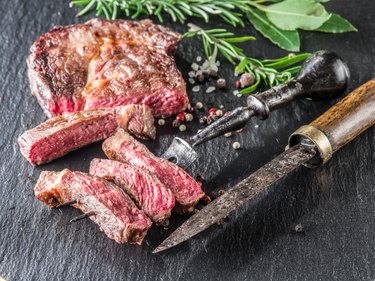
In the 19th century, little confusion existed as to which cut of steak was the star player at New York's famed Delmonico's Restaurant. But, for mysterious reasons — probably having to do with borrowed glory — the "Delmonico steak" has come to mean different things to different people. In fact, a "Delmonico cut" can now refer to several types of beef. In the modern era, many foodies consider the term as something of a nickname for rib-eye steak.
Give Delmonico Rib-Eye a Try
Video of the Day
Sure, "the Delmonico" is attributed to several cuts of meat, depending on whom you ask. But these days, it's the rib-eye steak that's most frequently used interchangeably with the term "Delmonico steak."
Video of the Day
The Delmonico rib-eye is one of the pricier cuts of meat, and it's cut from the front rib portion. It's famed for its tenderness and generous marbling of fat. Most of the Delmonico rib-eye steaks you buy or order will be boneless. Some establishments, however, do offer a bone-in version of the Delmonico rib-eye.
The generous fat content in the Delmonico rib-eye makes it perfect for high-heat, quick-cooking methods. These include pan-searing, broiling and grilling. To pan-sear this steak, heat oil to medium-high in a cast-iron skillet and baste with butter toward the end of the cooking process. Sear the rib-eye 3 to 4 minutes per side. A steak cooked to medium doneness and allowed to rest about 5 minutes will register as 145F on a meat thermometer.
Cook Up Some History
Most food historians agree that the cut now known simply as the boneless top sirloin was the star attraction at Delmonico's Restaurant in the 1800s and early 1900s. Modern sirloins aren't always tender, but the cuts used by the restaurant were reported to be about 2 inches thick and streaked with delicate veins of fat.
Opened in the 1830s in New York City, Delmonico's was the brainchild of the Del Monico brothers of Switzerland. The large restaurant became famous for its quality ingredients, as well as for the then-novel "bill of fare," which allowed diners to choose their own meals from a list of selections. The cooked-to-order Delmonico steak, the boneless top sirloin, was the restaurant's signature dish.
Want to make a historically accurate Delmonico steak? Choose a boneless top sirloin that's at least 2 inches thick and well-marbled with fat. Fire up the grill to approximate the live fire grills that the original Delmonico's chefs used. Sprinkle it with salt before placing the steak on the grill. As it cooks, baste it with butter. If you like, serve the cooked steak as Delmonico's did by dribbling each steak with thin steakhouse-style gravy.
Get to Know Other Delmonico Cuts
As many as nine different steaks have been called "Delmonico" over the years. But aside from the modern Delmonico rib-eye and the boneless top sirloin originally used at the restaurant, there are two other types of meat you're most likely to find labeled as a "Delmonico cut."
- Boneless top loin steak (New York strip steak). Whether boneless or bone-in, the
top loin steak has many other aliases aside from Delmonico steak, including
hotel steak, contre filet, Kansas City steak, ambassador steak and strip
loin steak — along with many variations of each of these aliases. When it's
specifically presented as a boneless cut, this "Delmonico" also goes by "shell
steak." This steak type is known for being extremely flavorful, which is why
it's on the expensive side.
- Bone-in top sirloin steak (club steak). In some regions, "club steak" and "Delmonico steak" are still used interchangeably. The sirloin is perhaps the least tender of all the loin cuts. It does, however, have even more flavor than cuts like tenderloin. The club steak is presented with the bone in, and it's taken from the top of the sirloin area.